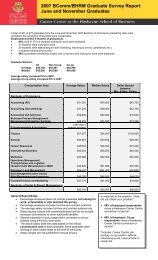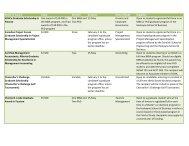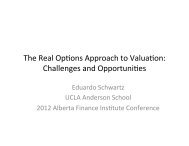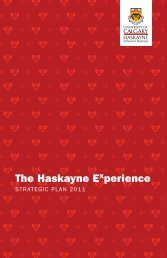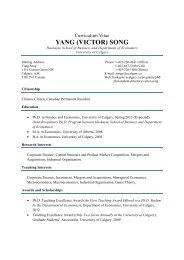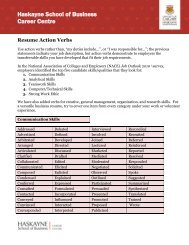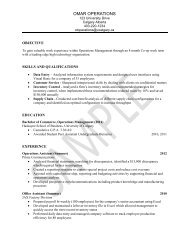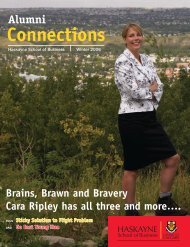Wind Farms on Alberta Crown Lands? - Haskayne School of Business
Wind Farms on Alberta Crown Lands? - Haskayne School of Business
Wind Farms on Alberta Crown Lands? - Haskayne School of Business
Create successful ePaper yourself
Turn your PDF publications into a flip-book with our unique Google optimized e-Paper software.
<str<strong>on</strong>g>Wind</str<strong>on</strong>g> <str<strong>on</strong>g>Farms</str<strong>on</strong>g> <strong>on</strong> <strong>Alberta</strong> <strong>Crown</strong> <strong>Lands</strong>?<br />
An IRIS Executive Briefing<br />
Key themes from research presented at a CPC-IRIS Public Seminar, March 17, 2010<br />
Allan Ingels<strong>on</strong><br />
Associate Pr<strong>of</strong>essor, Faculty <strong>of</strong> Law and the <strong>Haskayne</strong> <strong>School</strong> <strong>of</strong> <strong>Business</strong><br />
Ryan Kalt<br />
B.Comm., LLB, MBA, LLM<br />
Briefing # 10-02<br />
C<strong>on</strong>tact:<br />
Commissi<strong>on</strong>ing Editor: Dr. Frances Bowen, Director, IRIS<br />
Email: iris@haskayne.ucalgary.ca or ph<strong>on</strong>e: (403) 220-6073<br />
2500 University Drive NW, Calgary, <strong>Alberta</strong>, Canada T2N 1N4<br />
For more titles in this series: www.iriscentre.ca
Emerging <str<strong>on</strong>g>Wind</str<strong>on</strong>g> Farm Development in North<br />
America<br />
During November 2005, due to increased natural gas prices, retail<br />
customers in Colorado started paying less for electricity generated<br />
from wind farms than from fossil fuels for the first time. As stated in<br />
an editorial in the Denver Post “No l<strong>on</strong>ger an envir<strong>on</strong>mentalist’s<br />
pipe dream…wind is an energy source worthy <strong>of</strong> a bigger role in a<br />
growing state’s electrical needs” (Pernick p. 59).<br />
In the last five years there has been increased wind farm<br />
development in other U.S. states including Texas and California,<br />
and more interest in Canadian wind farms. <str<strong>on</strong>g>Wind</str<strong>on</strong>g> energy producti<strong>on</strong><br />
is expected to double in Canada between 2009 and 2015.<br />
To promote investment in this renewable energy source <strong>on</strong> public<br />
land in Ontario and British Columbia, the provincial governments<br />
have created a land dispositi<strong>on</strong> process that provides for <strong>Crown</strong><br />
wind energy leases. These regimes outline the process and rights<br />
associated with developing wind farms <strong>on</strong> public lands. The<br />
Ontario and B.C. governments have positi<strong>on</strong>ed themselves to<br />
obtain land rental, royalty and tax revenues from wind farm<br />
development.<br />
<str<strong>on</strong>g>Wind</str<strong>on</strong>g> <str<strong>on</strong>g>Farms</str<strong>on</strong>g> in <strong>Alberta</strong><br />
In 2007, the H<strong>on</strong>. Ed Stelmach, Premier <strong>of</strong> <strong>Alberta</strong> stated that<br />
“<strong>Alberta</strong> has the highest per capita <strong>of</strong> electricity generated by wind,<br />
and in overall generati<strong>on</strong> we are exceeded <strong>on</strong>ly by Ontario – which<br />
has twice the area and four times the populati<strong>on</strong>” (March 16, 2007<br />
speech to the Ft. Macleod and District Chamber <strong>of</strong> Commerce<br />
Annual Meeting).<br />
There has been significant wind energy development <strong>on</strong> private<br />
lands in <strong>Alberta</strong>, but a lack <strong>of</strong> wind farms <strong>on</strong> public <strong>Crown</strong> lands.<br />
While 60% <strong>of</strong> the land in <strong>Alberta</strong> is <strong>Crown</strong> land, the Minister <strong>of</strong><br />
Sustainable Resource Development in <strong>Alberta</strong> declared a<br />
moratorium <strong>on</strong> wind power project development <strong>on</strong> <strong>Crown</strong> land<br />
until a comprehensive energy strategy is put in place. In March<br />
2009, the <strong>Alberta</strong> Associati<strong>on</strong> <strong>of</strong> Municipal Districts and Counties<br />
called <strong>on</strong> the provincial government to “start granting companies<br />
the right to develop wind power turbine farms <strong>on</strong> leased <strong>Crown</strong><br />
land” (Canadian Press, “Rural Communities want <strong>Alberta</strong> to allow<br />
wind power farms <strong>on</strong> leased <strong>Crown</strong> land” Whitehorse Star, March<br />
23, 2009, 14)<br />
The lack <strong>of</strong> a <strong>Crown</strong> land dispositi<strong>on</strong> process in <strong>Alberta</strong> has prevented wind farm<br />
development <strong>on</strong> public lands. <strong>Alberta</strong> could learn from Ontario and BC how to develop,<br />
and gain revenue from, wind energy <strong>on</strong> public lands.
<str<strong>on</strong>g>Wind</str<strong>on</strong>g> Energy Revenue for the Ontario and<br />
B.C. Governments<br />
In 2005, the Ontario Government opened <strong>Crown</strong> lands for wind<br />
energy leases under the Public <strong>Lands</strong> Act. In some areas the<br />
provincial government receives a $20,000 applicati<strong>on</strong> fee in a n<strong>on</strong>competitive<br />
process and issues a land use permit for a wind<br />
energy developer to c<strong>on</strong>firm the ec<strong>on</strong>omic viability <strong>of</strong> a proposed<br />
wind farm. In other areas, competitive bidding is provided for.<br />
Commercial wind energy leases are granted for an initial term <strong>of</strong><br />
25 years with an extensi<strong>on</strong> period available. C<strong>on</strong>diti<strong>on</strong>s are<br />
stipulated in <strong>Crown</strong> wind energy leases that typically include a land<br />
rental payment schedule and royalties payable to the Ontario<br />
government. <str<strong>on</strong>g>Wind</str<strong>on</strong>g> farm lessees also pay property taxes to<br />
municipal governments.<br />
In B.C. the Ministry <strong>of</strong> Energy, Mines and Petroleum Resources<br />
(MEMPR) is resp<strong>on</strong>sible for land tenure policies for wind and<br />
independent power producers. The MEMPR implemented a rent<br />
policy for wind energy projects in 2005. There are investment<br />
incentives for wind farm development <strong>on</strong> B.C. <strong>Crown</strong> lands. <str<strong>on</strong>g>Wind</str<strong>on</strong>g><br />
farm producers do not pay participati<strong>on</strong> rents for the first ten years<br />
<strong>of</strong> commercial operati<strong>on</strong>s. Starting in year 11, wind farm<br />
producers pay from 1-3% <strong>of</strong> gross annual revenues <strong>on</strong> a sliding<br />
scale formula, based <strong>on</strong> annual electricity producti<strong>on</strong>.<br />
Useful Resources<br />
Brad Armstr<strong>on</strong>g, Krista Hughes & M<strong>on</strong>ica Balaski, “Permitting<br />
Issues in British Columbia and <strong>Alberta</strong>: <str<strong>on</strong>g>Wind</str<strong>on</strong>g> and Run-<strong>of</strong>-River<br />
Projects” (Paper presented to the B.C. Power Summit, June 2,<br />
2006);<br />
Pernick, R<strong>on</strong> and Clint Wilder (2008) “The clean tech revoluti<strong>on</strong>”<br />
Collins <strong>Business</strong>, New York;<br />
Helle Tegner Anker, Birgitte Egelund Olsen and Anita R<strong>on</strong>ne, <str<strong>on</strong>g>Wind</str<strong>on</strong>g><br />
Energy and the Law: A Comparative Analysis, 27(2) Journal <strong>of</strong><br />
Energy and Natural Resources Law (May 2009);<br />
Michael M. Wenig et al, (2007) Legal and Policy Frameworks for<br />
Renewable Energy in <strong>Alberta</strong>, Paper No. 12 <strong>of</strong> the <strong>Alberta</strong> Energy<br />
Futures Project, Institute for Sustainable Energy, Envir<strong>on</strong>ment and<br />
Ec<strong>on</strong>omy, University <strong>of</strong> Calgary.<br />
About IRIS:<br />
Established in 1994, IRIS: The Internati<strong>on</strong>al Resource<br />
Industries and Sustainability Centre, brings together<br />
expertise from the <strong>Haskayne</strong> <strong>School</strong> <strong>of</strong> <strong>Business</strong> and the<br />
Institute for Sustainable Energy, Envir<strong>on</strong>ment and<br />
Ec<strong>on</strong>omy (ISEEE) at the University <strong>of</strong> Calgary <strong>on</strong><br />
sustainable resource development.



